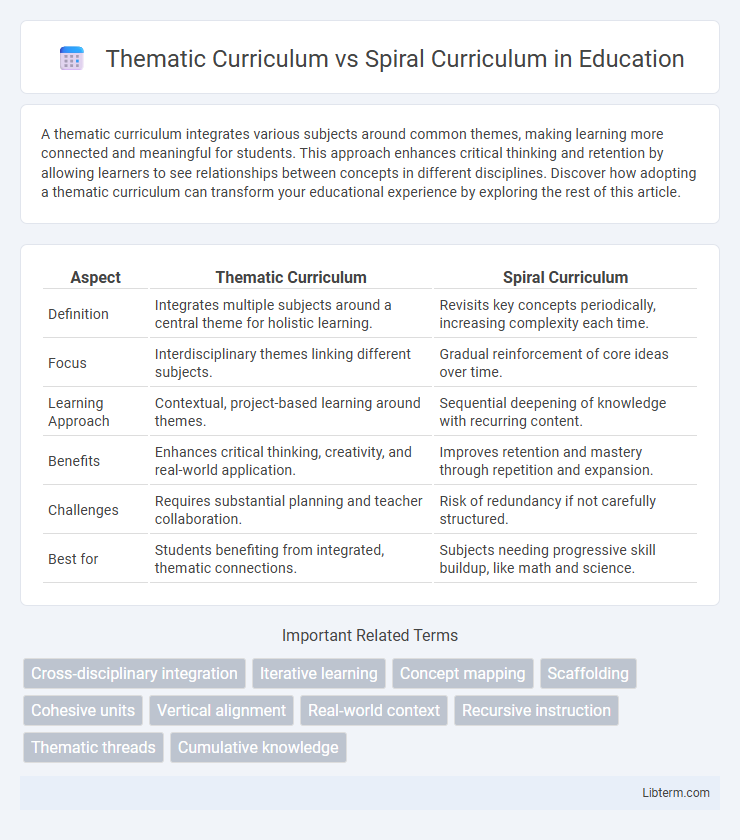A thematic curriculum integrates various subjects around common themes, making learning more connected and meaningful for students. This approach enhances critical thinking and retention by allowing learners to see relationships between concepts in different disciplines. Discover how adopting a thematic curriculum can transform your educational experience by exploring the rest of this article.
Table of Comparison
| Aspect | Thematic Curriculum | Spiral Curriculum |
|---|---|---|
| Definition | Integrates multiple subjects around a central theme for holistic learning. | Revisits key concepts periodically, increasing complexity each time. |
| Focus | Interdisciplinary themes linking different subjects. | Gradual reinforcement of core ideas over time. |
| Learning Approach | Contextual, project-based learning around themes. | Sequential deepening of knowledge with recurring content. |
| Benefits | Enhances critical thinking, creativity, and real-world application. | Improves retention and mastery through repetition and expansion. |
| Challenges | Requires substantial planning and teacher collaboration. | Risk of redundancy if not carefully structured. |
| Best for | Students benefiting from integrated, thematic connections. | Subjects needing progressive skill buildup, like math and science. |
Understanding Thematic Curriculum: Core Concepts
Thematic Curriculum integrates subjects around central themes, enhancing meaningful connections and contextual learning for students. Core concepts include interdisciplinary content, student-centered inquiry, and real-world relevance to foster deeper engagement and critical thinking. This approach contrasts with Spiral Curriculum, which revisits key topics with increasing complexity over time.
What Is Spiral Curriculum? Key Features
Spiral curriculum is an educational approach where key concepts are revisited and expanded upon over time, allowing students to build on prior knowledge systematically. Its key features include progressive complexity, continuous reinforcement, and cumulative learning, which promote deeper understanding and long-term retention. This method contrasts with thematic curriculum by emphasizing iterative exposure to topics rather than integrating subjects around themes.
Historical Background of Both Curriculum Models
Thematic curriculum emerged in the early 20th century with roots in progressive education, emphasizing integrated learning through central themes to connect knowledge across subjects. Spiral curriculum was conceptualized by Jerome Bruner in the 1960s, advocating for iterative revisiting of key concepts with increasing complexity to enhance mastery. Both models reflect evolving educational theories aimed at improving cognitive development and retention in students.
Designing Lessons: Thematic vs Spiral Approaches
Designing lessons using a thematic curriculum centers on integrating multiple subjects around a central theme, fostering holistic understanding and real-world connections. In contrast, the spiral curriculum structures lesson design by revisiting core concepts repeatedly with increasing complexity, promoting incremental learning and reinforcement over time. Thematic lessons emphasize interdisciplinary connections, while spiral lessons prioritize curriculum continuity and concept mastery through cyclical revisits.
Benefits of Thematic Curriculum for Student Engagement
Thematic Curriculum enhances student engagement by integrating multiple subjects around common themes, fostering deeper understanding and relevance. This approach encourages critical thinking and creativity through real-world connections and collaborative projects. Students remain motivated and actively participate, as learning becomes more meaningful and connected to their interests.
Advantages of Spiral Curriculum for Knowledge Retention
The Spiral Curriculum enhances knowledge retention by revisiting key concepts repeatedly over time, allowing learners to build deeper understanding with each encounter. This iterative approach reinforces memory pathways and promotes long-term retention by connecting new information to previously learned material. Emphasizing gradual complexity, the Spiral Curriculum adapts to students' cognitive development, making learning more effective and durable compared to one-time thematic exposure.
Challenges and Limitations in Implementation
Thematic Curriculum often faces challenges in maintaining subject depth and ensuring comprehensive skill development due to its integrated approach, which may lead to uneven coverage of disciplines. Spiral Curriculum encounters limitations with pacing and student readiness, requiring careful iteration of concepts that can be difficult to tailor for diverse learning speeds. Both curricula demand significant teacher training and resource allocation, posing implementation barriers in under-resourced educational settings.
Adapting Curriculum Models for Different Age Groups
Thematic curriculum integrates subjects around central themes, promoting holistic understanding, which suits younger students by connecting learning to their interests and environment. Spiral curriculum revisits topics with increasing complexity over time, ideal for older students as it reinforces prior knowledge and deepens comprehension through cumulative learning stages. Adapting these models involves using thematic structures for early education to spark engagement, while employing spiral approaches in middle and high school to build mastery and critical thinking skills.
Teacher Roles and Training Requirements
Teacher roles in a thematic curriculum emphasize integrating interdisciplinary content and facilitating student-centered exploration, requiring training in collaborative planning and flexible instructional strategies. In contrast, spiral curriculum teachers focus on revisiting core concepts with increasing complexity, needing training in scaffolding techniques and progressive assessment methods. Both approaches demand professional development that adapts to their distinct pedagogical structures and student engagement models.
Choosing the Right Curriculum: Factors to Consider
Choosing the right curriculum involves evaluating learning objectives, student engagement, and content retention. Thematic Curriculum integrates subjects around central themes, promoting deeper understanding through real-world connections, while Spiral Curriculum revisits topics repeatedly at increasing levels of complexity to reinforce mastery. Factors such as age group, subject matter, and educational goals determine which approach enhances cognitive development and supports long-term learning outcomes most effectively.
Thematic Curriculum Infographic

 libterm.com
libterm.com